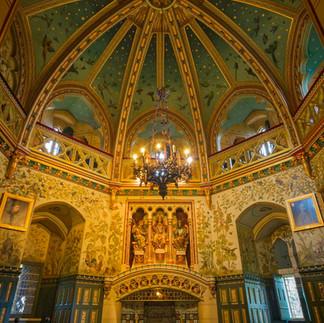The 3rd Marquess of Bute and William Burgess
- Janet Myers
- Aug 5, 2024
- 3 min read

Image Jonathan Myers
Not many tourists visiting Cardiff are familiar with the close bond shared between the affluent 3rd Marquess Bute, the former owner of the Cardiff Castle, and the architect William Burgess, who was entrusted with the project of revamping a significant portion of the castle. The interior is outstanding …..
Images from Cardiff Castle’s web site showing the work of William Burgess
The 3rd Marquess of Bute William Burgess
This friendship also resulted in another lavish interior. This one can be found in a Fairy tale castle over which the Marquess gave him full creative control . It stands not far from the city is is known as Castel Coch. It rises from the forest like a vision from a fairytale. Its conical roofs worthy of Rapunzel or Sleeping Beauty.
Castel Coch
So lets cross the drawbridge and take a tour; come inside and explore winding stone staircases, secret passages and vibrant magical chambers. Visit its dank dungeons and stunning central courtyard. Perhaps even experience a fairytale wedding in this opulent setting
Its interior is a dazzling masterpiece of ornate colour embellished with gold and worthy of any medieval royalty. It is visited by thousands and used in many movie sets but in actual fact it is no more than a folly constructed in the Victorian era by the 3rd Marquess of Bute who gave architect William Burgess free rein to create something extraordinary. That however cannot take away from its imaginary which transports visitors back hundreds of years to a world where life was very different from today.
Unlike most follies built on virgin sites Castell Coch is built on the site of the impressive remains of a 13 th century castle once used as a hunting lodge by the ruthless Marcher lord Gilbert de Clare and the lower portions of the castle date from that time…….
So why did my thoughts today turn to cardiff and its association with the Bute family …
Well it was my recent visit to Cardiff for a photo shoot and a stop for a glass of wine and a bite to eat in Bute Street

Cardiff Bay
Cardiff Bay was formally the docks created by the second Marquis of Bute. It had a tide which rose and fell over 14 feet to reveal mud flats but with the building of a barrage it has become an enclosed expanse of water surrounded with restaurants and many interesting places to visit including the Sennodd - the Welsh Assembly building, Butetown History and Arts Centre, the Norwegian Church Arts Centre and the Wales Millennium Centre.

A statue created by John Clinch, portraying two figures with a dog, is easily seen from the waterfront. This sculpture represents the multicultural community that developed as a result of the port's importance as a coal distribution center, drawing individuals from different countries worldwide. During 1913, on the eve of the First World War, coal exports in the adjacent Bute street Coal exchange building peaked at over 13 million tonnes and it was here that the world's first £1 million pound deal was signed.
Bute Park was once the castle grounds and Butetown was originally a model housing estate built in the early 19th century by the 2nd Marquess of Bute.
Bute Park also has another unusual attribute for it contains a wild flower garden known as bat meadow created in 2017 to provide a diverse and attractive habitat for insects and pollinators as a food source for bats with the hope of increasing the bat population. It also attracts small mammals and amphibians offering them hiding places, food and nesting material.
Wherever you visit in Cardiff the name Bute will be found again and again so take an open top bus tour and discover even more fascinating facts about this influential family.








































Comments